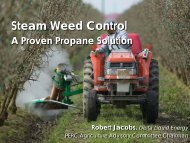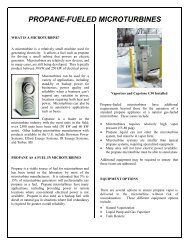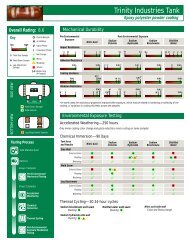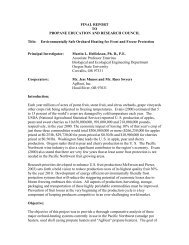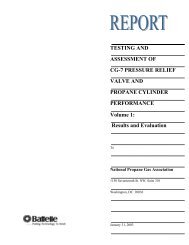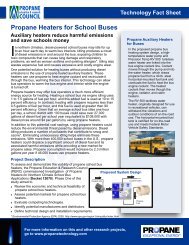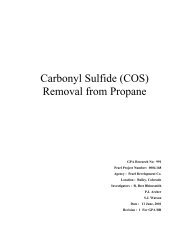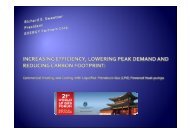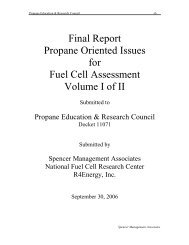Testing Underground Propane Tank Coatings - Propane Education ...
Testing Underground Propane Tank Coatings - Propane Education ...
Testing Underground Propane Tank Coatings - Propane Education ...
You also want an ePaper? Increase the reach of your titles
YUMPU automatically turns print PDFs into web optimized ePapers that Google loves.
<strong>Testing</strong> <strong>Underground</strong><br />
<strong>Propane</strong> <strong>Tank</strong> <strong>Coatings</strong><br />
Research Fact Sheet<br />
Steel underground tanks store safe, clean, reliable<br />
propane for a wide range of residential needs.<br />
Mastic or thermoplastic outer coatings help tanks<br />
perform reliably over the long term by protecting<br />
tanks from the potentially damaging effects of<br />
exposure to moisture, bacteria, and minerals in the<br />
soil.<br />
These environmental factors, combined with tank<br />
coating application issues, can reduce the long-term<br />
corrosion protection offered by underground<br />
propane tank coatings. A recent research study<br />
evaluates the performance of several tank coating<br />
types to help marketers better understand and<br />
compare the performance of various tank coatings.<br />
Failure to provide proper [tank] protection can cause hidden<br />
corrosion and potential leaks as well as weakening of the tank<br />
wall over a period of time.<br />
– National <strong>Propane</strong> Gas Association,<br />
No. 412 — Installation of <strong>Underground</strong><br />
LP-Gas Systems<br />
Residential<br />
Agriculture<br />
Industrial/<br />
Commercial<br />
Engine Fuel<br />
R&D<br />
Research Status: Results Available<br />
The study was completed in 2009.<br />
The comparative tank coating performance data<br />
collected during the study is presented in a visual<br />
summary piece and a detailed project report. Both<br />
are available at www.propaneresearch.com.<br />
The study’s results will help propane marketers and<br />
retailers select the best tank and coating for a<br />
specific customer or application.<br />
Supporting Facts<br />
<br />
<br />
<br />
<br />
<strong>Coatings</strong> protect underground propane tanks from<br />
moisture, bacteria, and minerals.<br />
Pinholes, gaps in the coating, disbondments (loss of<br />
adhesion), and incomplete or uneven application can<br />
affect the tank’s susceptibility to corrosion.<br />
The effectiveness of different coating types can vary<br />
under different environmental conditions.<br />
The detailed data in this report can identify how<br />
variations in tank surface preparation, coating<br />
application, and environmental issues impact tank<br />
coating performance.<br />
Result Highlights: Overall Performance Rating<br />
Trinity Industries epoxy polyester powder<br />
American Welding & <strong>Tank</strong> epoxy polyester powder<br />
Quality Steel Corporation epoxy polyester urethane liquid<br />
Liberty <strong>Tank</strong> & Vessels polyethlylene powder<br />
Thompson <strong>Tank</strong>s coal tar epoxy powder<br />
Liberty <strong>Tank</strong> & Vessels coal tar epoxy liquid<br />
American Welding & <strong>Tank</strong> epoxy polyester liquid<br />
For more information on this and other research projects,<br />
go to www.propaneresearch.com.<br />
0 1 2 3 4 5 6 7 8 9 10
A Closer Look<br />
<strong>Testing</strong> <strong>Underground</strong> <strong>Propane</strong> <strong>Tank</strong> <strong>Coatings</strong>: Collection of Test Samples<br />
Group 1: Mechanical <strong>Testing</strong><br />
Five 6-inch-by-6-inch samples were taken from the following<br />
places on each tank: a leg attachment, the end, the top,<br />
the side, and a weld point. Oversized samples were<br />
removed and were then carefully cut to size using a band<br />
saw to ensure that the tank coatings were not damaged.<br />
Side view of tank<br />
Legs<br />
Leg attachment sample<br />
End sample<br />
<strong>Tank</strong> top sample<br />
<strong>Tank</strong> side sample<br />
Weld line sample<br />
Group 2: Environmental and Mechanical <strong>Testing</strong><br />
From each tank, 25 4-inch-by-6-inch samples were taken, as<br />
follows: 10 samples from the weld line, 10 samples from the<br />
side of the tank, and five samples from the areas where the<br />
tank legs are attached to the tank.<br />
Side view of tank<br />
Bottom view of tank<br />
Legs<br />
Weld line sample<br />
<strong>Tank</strong> side sample<br />
Leg attachment sample<br />
Project: <strong>Testing</strong> and Evaluation of <strong>Underground</strong> <strong>Propane</strong> <strong>Tank</strong> <strong>Coatings</strong> (Docket 12469)<br />
Partner:<br />
KTA-TATOR Inc.<br />
Research Process<br />
Sample Selection<br />
Tested the coatings applied to seven 500-pound tanks from five U.S. propane tank manufacturers. Three of the tanks<br />
had liquid-applied coatings, and four had powder coatings.<br />
<strong>Testing</strong> and Evaluation<br />
Evaluated the initial condition of the tank coatings and collected coating test samples.<br />
Performed mechanical testing (including adhesion, hardness, and impact resistance testing) on Group 1 samples.<br />
Performed environmental exposure testing (including accelerated weathering, chemical immersion, and thermal cycling)<br />
on Group 2 samples.<br />
Performed mechanical tests on the Group 2 samples that had completed environmental exposure testing.<br />
Results<br />
Powder coatings outperform liquid coatings. Overall, powder coatings consistently outperformed liquid coatings;<br />
three of the four top-performing coatings were powders.<br />
<strong>Coatings</strong> on welded seam areas perform worse than coatings on side and leg areas. Chemical immersion<br />
caused the most damage on the welded seam areas of five of the seven tanks. Overall, the welded seam areas often<br />
performed worse than the side and leg attachment samples for the same tank.<br />
Local, careful tank delivery is essential. Six of seven tanks arrived with handling damage from common carrier<br />
delivery. The one tank delivered by the supplier arrived with only minor abrasions.<br />
What’s Next<br />
For more information, visit www.propaneresearch.com to view the Evaluation of <strong>Underground</strong> <strong>Propane</strong> <strong>Tank</strong> <strong>Coatings</strong>:<br />
Docket 12469 Final Report and the visual summary results of the testing for each tank coating.<br />
FOR MORE INFORMATION:<br />
<strong>Propane</strong> <strong>Education</strong> & Research Council<br />
Gregory Kerr, Director of Research and Development<br />
1140 Connecticut Ave. NW, Suite 1075<br />
Washington, DC 20036<br />
202-452-8975<br />
www.propaneresearch.com<br />
www.usepropane.com<br />
PROJECT PARTNER:<br />
KTA-TATOR Inc.<br />
William D. Corbett, Technical Services Manager<br />
115 Technology Drive<br />
Pittsburgh, PA 15213<br />
412-788-1300<br />
March 2010



